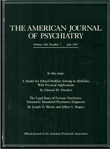Reliability and validity of emotional blunting as a criterion for diagnosis of schizophrenia
Abstract
The authors tested the usefulness of emotional blunting as a criterion for the diagnosis of schizophrenia on 130 patients with Research Diagnostic Criteria (RDC), diagnoses of schizophrenia, schizoaffective disorder, and affective disorder, using both a scale devised by Abrams and Taylor and a global item from the Schedule for Affective Disorders and Schizophrenia. Reliability for both measures was very high. The results did not support the use of emotional blunting as a value criterion for the RDC diagnosis of schizophrenia, although it may be useful in differentiating subtypes of schizophrenia and as an exclusion criterion for affective disorders. There was no advantage in using a scale rather than a single rating measure for assigning diagnoses.
Access content
To read the fulltext, please use one of the options below to sign in or purchase access.- Personal login
- Institutional Login
- Sign in via OpenAthens
- Register for access
-
Please login/register if you wish to pair your device and check access availability.
Not a subscriber?
PsychiatryOnline subscription options offer access to the DSM-5 library, books, journals, CME, and patient resources. This all-in-one virtual library provides psychiatrists and mental health professionals with key resources for diagnosis, treatment, research, and professional development.
Need more help? PsychiatryOnline Customer Service may be reached by emailing [email protected] or by calling 800-368-5777 (in the U.S.) or 703-907-7322 (outside the U.S.).



